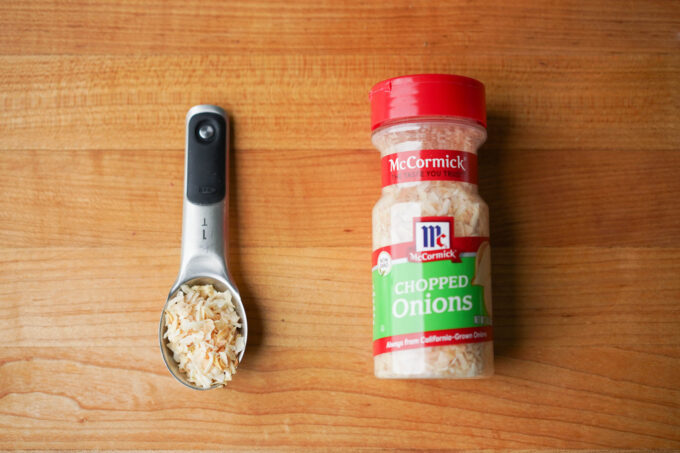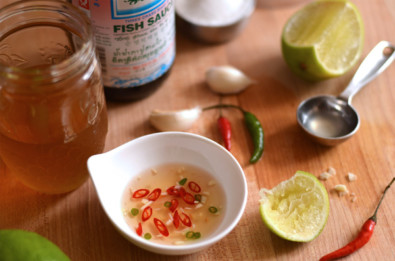The recipe you’re about to cook calls for a ½ cup of freshly diced onion, and you look in your fridge or larder or pantry (or wherever you store onions), and the onion you thought you had wasn’t there.
You can still get that oniony flavor by substituting fresh onion for dried minced onion or onion powder. I use both frequently, especially when I couldn’t be bothered to cut an onion into a perfect ¼-inch dice.

When to use an onion substitute
Fresh onion is 89% water, so as it cooks, the water is released, and depending on the recipe, it softens the onion into buttery, caramelized deliciousness, or you adjust how much liquid you add to a recipe, like for Wonton Soup.
Dried minced onion needs to be rehydrated by either soaking it in water before adding it to a recipe or while it cooks in a sauce. Dried onion will give the same flavor as fresh onion, but there is a texture difference: Even soaking them in sauce, they still don’t quite get soft enough. That little crunch, though, can add a nice bite to potato salad.

Onion powder blends easily, especially if you’re making a sauce for something like Vietnamese Chicken Curry or for a filling in spring rolls. I have to admit that I actually use onion powder a few times a week. Even if a recipe doesn’t call for it, I sprinkle a little in, just to give the dish a flavor boost.
It’s especially fantastic for roasting vegetables and baking tofu. All you need to do is toss the veggies with a little bit of olive oil, salt and pepper and a ¼ teaspoon onion powder — and culinary magic happens in your oven.
Dried minced onion vs onion powder

Dried minced onion and onion powder aren’t the same thing — although they both started as fresh onion — and you have to know how much to use in place of fresh onion, or your finished meal will be overpowered by ONION.
Fresh onion substitutes

If you’re making a soup or stew and you realize last minute that you’re out of the fresh diced onion it calls for, you can make substitutes to still get that oniony flavor.
Substituting fresh with dried onion
If the recipe calls for 1 cup chopped fresh onion, you can substitute 3 tablespoons of dried minced onion, or 1 tablespoon onion powder since it’s much more potent.
Of course for dishes that require the raw crunchy texture of onion, this replacement won’t work, but for soups and stews where the fresh onion would get cooked down anyway, this works well!
Substituting yellow with red onions

Yellow and red onions taste slightly different, but in a pinch they can be substituted for each other one to one. Whether its raw for a salad topping, or in a soup, you can replace one with the other. Be aware the purpleish red color in red onions will leech out when cooked though so if you have a pale or light colored recipe you’re cooking, it can redden or darken the food. Even for recipes like pickling, you will have some color leech out into the pickling liquid.
Dried onion substitutes

Dried onion comes in two forms — flakes and minced — though minced is the one you’ll see most often in the spice aisle. It’s made by dehydrating fresh chopped white onions. (Every now and then I see dried red onion in the store.)
The dehydration intensifies the onion’s flavor, so when you’re substituting dried onion for fresh onion, you’ll need much less.
For example, for 1 cup of fresh onion, you would substitute 3 tablespoons of dried onion. Similarly, if the recipe calls for 1 tablespoon dried onion and you don’t have it, you can use 1 teaspoon onion powder, or about 1/3 cup of fresh chopped onion.
Onion powder substitutes

Onion powder is basically dried onion that’s been ground. Although dried onion is just the onion flesh, onion powder can also include dehydrated onion skins and roots.
Onion powder is three times more potent than dried onion, so for 1 cup of fresh onion, you would substitute only 1 tablespoon of onion powder.
Similarly if your recipe calls for 1 tablespoon onion powder and you need to sub it, use 3 tablespoons dried minced onion, or 1 cup chopped fresh onion.
Green onion substitutes
Green onions add fresh hit of color and are typically added last minute to a dish so it retains the bright green and some crunch. The qualities of green onion are unique but you can make some subsitutes in a pinch.
How to substitute
You can substitute with leeks in cooked food, but use a slightly lower ratio of leeks since the flavor is stronger. Another option in cooked food is shallots. Although green onions are more mild than yellow or white onion, they are stronger tasting than green onion, so use it mindfully.
If you were supposed to use raw green onion, chives can be used for the bright green look and oniony flavor, but they are softer in texture and don’t have the same crunch.
If its for a raw recipe like salad or tacos, you may need to slice these onions thinner since they are more potent.
Onion substitution chart
| Chopped Fresh Onion | Dried Minced Onion | Onion Powder |
|---|---|---|
| 1/4 cup | 3/4 tablespoon | 3/4 teaspoon |
| 1/3 cup | 1 tablespoon | 1 teaspoon |
| 1/2 cup | 1-1/2 tablespoons | 1/2 tablespoon |
| 2/3 cup | 2 tablespoons | 2 teaspoons |
| 3/4 cup | 2-1/4 tablespoons | 2-1/4 teaspoons |
| 1 cup | 3 tablespoons | 1 tablespoon |
How much onion substitute to use
Let’s first clarify how much a small, medium or large onion will yield. One of my pet peeves is seeing a recipe instruction that says “chop 1 small onion.” But just how big is “small?” And how much larger is considered “medium?” Most of the time, I just chop up a large onion and save what I don’t use. (Onion freezes really well when it’s sealed in a ziploc bag.)
A general approximation, though, if you don’t feel like using a measuring cup, is:
- Small onion — about the size of a Roma tomato — will give you 4 ounces or ½ cup chopped
- Medium onion — about the size of a turnip — will give you 8 ounces or 1 cup chopped
- Large onion — about the size of a pomegranate —- will give you 12 ounces or 1-½ cups chopped.
This chart tells you how to convert fresh onion to dried onion and onion powder.










Thanks SO much!!! This article was enormously helpful, covering, as it does, all the forms of onions that are available at the store. Now I will never be confused about how much to use of any of them for a recipe!